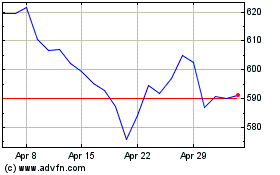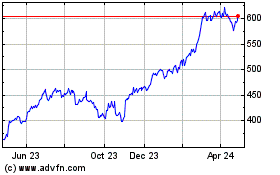Martin Marietta Materials, Inc. Updates 2009 Earnings Expectations
July 13 2009 - 6:15PM
Business Wire
Martin Marietta Materials, Inc. (NYSE:MLM) reported today that
it now expects 2009 net earnings to be in a range of $2.70 to $3.30
per diluted share. The revised earnings range is driven by three
primary factors: (i) a weaker and slower-than-expected recovery of
the general United States economy; (ii) a marked decrease in
transportation infrastructure spending resulting from a decline in
state revenues and a longer-than-expected delay in federal stimulus
projects moving to the construction stage; and (iii) an adverse
weather-affected first half of the year.
Stephen P. Zelnak, Jr., Chairman and Chief Executive Officer of
Martin Marietta Materials commented, "As we have consistently
indicated, we have expected our 2009 performance to be driven
primarily by anticipated economic growth in the second half of the
year. This growth was to be principally fueled by federal economic
stimulus, or the American Recovery and Reinvestment Act, which was
specifically crafted to provide for increased construction and for
investment in the nation's infrastructure.
"Among other things, this stimulus program was designed to
address job creation as well as the underlying demand in
infrastructure repair and expansion together with
industrial-related construction activity. While we have seen an
increase in bidding activity for infrastructure projects and
awarding of projects to successful bidders by a significant number
of states, we now believe that 25% of projects will commence later
in the year with most of the remainder coming in 2010. The pace at
which these projects have moved to the actual construction stage,
to date, is slower than expected even though the majority of the
work is resurfacing. Aside from the federal programs, a number of
states are challenged with their own budgets as revenues decline.
This has caused most states to pull back and defer on state funded
projects.
"We have seen resurgence in alternative-energy construction
projects, namely wind farms in Iowa and south Texas, and we are
benefiting from the continued strength of the farm economy through
our position in the Midwest. Commercial construction activity
remains weak, primarily in office and retail construction, and
there has been little change in the residential construction
markets, although the indicators point to the beginning of recovery
in the second half of 2009.
"We continue to adjust our operating plan in response to the
current economic environment with a strict focus on cost
containment and maintaining our strong financial base. Favorable
energy prices have helped mitigate the impact of declining volumes
on the operating leverage of the aggregates business and we
continue to maintain excellent productivity, as measured by tons
per worked man hour. We are carefully controlling headcount as well
as the number of hours worked. We have fully integrated the
aggregates quarries that we acquired from Cemex in June 2009 and
are positive about their contribution this year and going
forward.
"Our Specialty Products segment has experienced a decline in
dolomitic lime volume, which is used in both our chemicals products
and as a fluxing agent in steel production. With steel production
forecasted to decline in line with general industrial demand, we do
not expect volume growth in dolomitic lime in 2009.
"Based upon our current economic view, our 2009 guidance of net
earnings per diluted share in the range of $2.70 to $3.30,
including the effect of the economic stimulus plan, incorporates
the following assumptions: aggregates volumes to range from down
13% to 18% compared with 2008; the rate of price increase for the
aggregates product line to range from 3.5% to 5% compared with
2008; and Specialty Products segment to contribute $28 million to
$30 million in pretax earnings.
"Although it is too early to provide guidance for 2010, we have
begun to frame our view on the upcoming year. As noted above, we
see some of the projects that we had earlier anticipated to
commence in 2009 now beginning next year. Specifically, we believe
there will be a significant increase in infrastructure related
projects as the effects of federal economic stimulus work their way
into the economy. We continue to believe we will see a moderate
increase in aggregates volume to portions of home building and
steady growth for chemical grade aggregates used for flue gas
desulfurization and in agricultural lime, as well as ballast used
in the railroad industry. These markets cumulatively comprised 69%
of our 2008 aggregates volumes, and we expect them to increase in
2010. Commercial construction represents the balance of our
aggregates volume and, while we expect a decline in commercial
construction volumes in 2010, we do not have meaningful visibility
into these markets at this time. Aggregates pricing growth in 2010
is expected to trend closer to our 20-year average," Zelnak
concluded.
RISKS TO EARNINGS EXPECTATIONS
The 2009 estimated earnings range includes management's
assessment of the likelihood of certain risk factors that will
affect performance within the range. The most significant risk to
2009 earnings, whether within or outside current earnings
expectations, will be, as previously noted, the performance of the
United States economy and that performance's effect on construction
activity. Management has estimated its earnings range, assuming a
stabilization of the United States economy in the second half of
2009. Should the second half 2009 stabilization not occur or the
economy is worse than currently expected, earnings could vary
significantly.
Risks to the earnings range are primarily volume-related and
include a greater-than-expected drop in demand as a result of the
continued decline in commercial construction, a further decline in
residential construction, continued delays in infrastructure
projects, or some combination thereof. Further, increased highway
construction funding pressures as a result of either federal or
state issues can affect profitability. Currently, nearly all states
are experiencing state-level funding pressures driven by lower tax
revenues and an inability to finance approved projects. North
Carolina and Texas are among the states experiencing these
pressures and these states disproportionately affect revenue and
profitability. The level of aggregates demand in the Corporation's
end-use markets, production levels and the management of production
costs will affect the operating leverage of the Aggregates business
and, therefore, profitability.
Production costs in the Aggregates business are also sensitive
to energy prices, both directly and indirectly. Diesel and other
fuels change production costs directly through consumption or
indirectly in the increased cost of energy-related consumables,
namely steel, explosives, tires and conveyor belts. Changing diesel
costs also affect transportation costs, primarily through fuel
surcharges in our long-haul distribution network. The Corporation's
earnings expectations do not include rapidly increasing diesel
costs or sustained periods of increased diesel fuel cost during
2009 at the level experienced in 2008 and, in fact, expectations
are that reduced diesel costs will contribute $35 million to $50
million in profitability in 2009. The Corporation experienced
favorable diesel costs in the first quarter 2009, but there is no
guarantee that this level of cost decrease will continue. The
availability of transportation in the Corporation's long-haul
network, particularly the availability of barges on the Mississippi
River system and the availability of rail cars and locomotive power
to move trains, affects the Corporation's ability to efficiently
transport material into certain markets, most notably Texas,
Florida and the Gulf Coast region. The Aggregates business is also
subject to weather-related risks that can significantly affect
production schedules and profitability. Atlantic Ocean and Gulf
Coast hurricane activity is most acute from June to November and
can cause significant disruption to production activity and
increase production costs. Opportunities to reach the upper end of
the earnings range depend on demand exceeding expectations for the
aggregates product line.
Risks to earnings outside of the range include a change in
volume beyond current expectations as a result of economic events
outside of the Corporation's control. In addition to the impact on
commercial and residential construction, the Corporation is exposed
to risk in its earnings expectations from tightening credit markets
and the availability of and interest cost related to its debt. If
volumes decline worse than expected, the Corporation is exposed to
greater risk in its earnings, including its debt covenant, as the
pressure of operating leverage increases disproportionately.
Martin Marietta Materials is a leading producer of construction
aggregates and a producer of magnesia-based chemical and dolomitic
lime. For more information about Martin Marietta Materials, refer
to our Web site at www.martinmarietta.com.
Investors are cautioned that all statements in this Press
Release that relate to the future involve risks and uncertainties,
and are based on assumptions that the Corporation believes in good
faith are reasonable but which may be materially different from
actual results. Factors that the Corporation currently believes
could cause actual results to differ materially from the
forward-looking statements in this press release include, but are
not limited to business and economic conditions and trends in the
markets the Company serves; the level and timing of federal and
state transportation funding; levels of construction spending in
the markets the Company serves; unfavorable weather conditions;
ability to recognize quantifiable savings from internal expansion
projects; ability to successfully integrate acquisitions quickly
and in a cost-effective manner; fuel costs; transportation costs;
competition from new or existing competitors; and other risk
factors listed from time to time found in the Corporation's filings
with the Securities and Exchange Commission. The Corporation
assumes no obligation to update any such forward-looking
statements.
MLM-G
Martin Marietta Materials (NYSE:MLM)
Historical Stock Chart
From Jun 2024 to Jul 2024

Martin Marietta Materials (NYSE:MLM)
Historical Stock Chart
From Jul 2023 to Jul 2024
